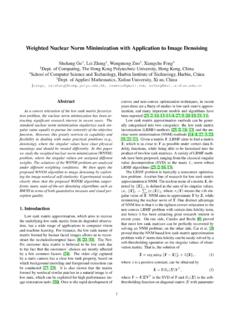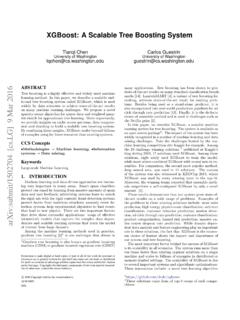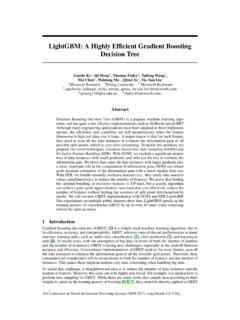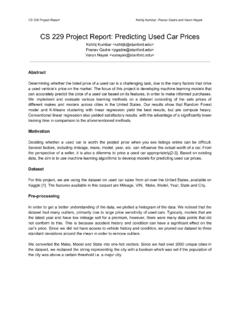Transcription of Beyond a Gaussian Denoiser: Residual Learning of Deep …
1 1. Beyond a Gaussian denoiser : Residual Learning of Deep CNN for Image Denoising Kai Zhang, Wangmeng Zuo, Senior Member, IEEE, Yunjin Chen, Deyu Meng, Member, IEEE, and Lei Zhang Senior Member, IEEE. Abstract Discriminative model Learning for image denoising various models have been exploited for modeling image priors, has been recently attracting considerable attentions due to its including nonlocal self-similarity (NSS) models [1], [2], [3], favorable denoising performance. In this paper, we take one [4], [5], sparse models [6], [7], [8], gradient models [9], [10], step forward by investigating the construction of feed-forward denoising convolutional neural networks (DnCNNs) to embrace [11] and Markov random field (MRF) models [12], [13], [14].
2 The progress in very deep architecture, Learning algorithm, and In particular, the NSS models are popular in state-of-the- regularization method into image denoising. Specifically, Residual art methods such as BM3D [2], LSSC [4], NCSR [7] and Learning and batch normalization are utilized to speed up the WNNM [15]. training process as well as boost the denoising performance. Despite their high denoising quality, most of the denoising Different from the existing discriminative denoising models which usually train a specific model for additive white Gaussian noise methods typically suffer from two major drawbacks.
3 First, (AWGN) at a certain noise level, our DnCNN model is able those methods generally involve a complex optimization prob- to handle Gaussian denoising with unknown noise level ( , lem in the testing stage, making the denoising process time- blind Gaussian denoising). With the Residual Learning strategy, consuming [7], [16]. Thus, most of the methods can hardly DnCNN implicitly removes the latent clean image in the hidden achieve high performance without sacrificing computational layers. This property motivates us to train a single DnCNN. model to tackle with several general image denoising tasks such efficiency.
4 Second, the models in general are non-convex and as Gaussian denoising, single image super-resolution and JPEG involve several manually chosen parameters, providing some image deblocking. Our extensive experiments demonstrate that leeway to boost denoising performance. our DnCNN model can not only exhibit high effectiveness in To overcome the above drawbacks, several discriminative several general image denoising tasks, but also be efficiently Learning methods have been recently developed to learn implemented by benefiting from GPU computing. image prior models in the context of truncated inference Index Terms Image Denoising, Convolutional Neural Net- procedure.
5 The resulting models are able to get rid of the works, Residual Learning , Batch Normalization iterative optimization procedure in the test phase. Schmidt and Roth [17] proposed a cascade of shrinkage fields (CSF). I. I NTRODUCTION method that unifies the random field-based model and the unrolled half-quadratic optimization algorithm into a single Image denoising is a classical yet still active topic in low Learning framework. Chen et al. [18], [19] proposed a trainable level vision since it is an indispensable step in many practical nonlinear reaction diffusion (TNRD) model which learns a applications.
6 The goal of image denoising is to recover a clean modified fields of experts [14] image prior by unfolding a image x from a noisy observation y which follows an image fixed number of gradient descent inference steps. Some of the degradation model y = x + v. One common assumption other related work can be found in [20], [21], [22], [23], [24], is that v is additive white Gaussian noise (AWGN) with [25]. Although CSF and TNRD have shown promising results standard deviation . From a Bayesian viewpoint, when the toward bridging the gap between computational efficiency and likelihood is known, the image prior modeling will play a denoising quality, their performance are inherently restricted to central role in image denoising.
7 Over the past few decades, the specified forms of prior. To be specific, the priors adopted This project is partially supported by HK RGC GRF grant (under no. PolyU in CSF and TNRD are based on the analysis model, which is 5313/13E) and the National Natural Scientific Foundation of China (NSFC) limited in capturing the full characteristics of image structures. under Grant No. 61671182, 61471146, 61661166011 and 61373114. In addition, the parameters are learned by stage-wise greedy K. Zhang is with the School of Computer Science and Technology, Harbin Institute of Technology, Harbin 150001, China, and also with the Department training plus joint fine-tuning among all stages, and many of Computing, The Hong Kong Polytechnic University, Hong Kong (e-mail: handcrafted parameters are involved.)
8 Another nonnegligible drawback is that they train a specific model for a certain noise W. Zuo is with the School of Computer Science and Technology, Harbin Institute of Technology, Harbin 150001, China (Corresponding author; e-mail: level, and are limited in blind image denoising. In this paper, instead of Learning a discriminative model with Y. Chen is with the Institute for Computer Graphics and Vision, Graz an explicit image prior, we treat image denoising as a plain University of Technology, Inffeldgasse 16, A-8010 Graz, Austria (e-mail: chenyunjin discriminative Learning problem, , separating the noise from D.))
9 Meng is with the School of Mathematics and Statistics and Ministry a noisy image by feed-forward convolutional neural networks of Education Key Lab of Intelligent Networks and Network Security, Xi'an (CNN). The reasons of using CNN are three-fold. First, CNN. Jiaotong University, Xi'an 710049, China (e-mail: L. Zhang is with the Department of Computing, The Hong Kong Polytech- with very deep architecture [26] is effective in increasing the nic University, Hong Kong (e-mail: capacity and flexibility for exploiting image characteristics. 2. Second, considerable advances have been achieved on regu- 2) We find that Residual Learning and batch normalization larization and Learning methods for training CNN, including can greatly benefit the CNN Learning as they can not Rectifier Linear Unit (ReLU) [27], batch normalization [28] only speed up the training but also boost the denoising and Residual Learning [29].)
10 These methods can be adopted performance. For Gaussian denoising with a certain in CNN to speed up the training process and improve the noise level, DnCNN outperforms state-of-the-art meth- denoising performance. Third, CNN is well-suited for parallel ods in terms of both quantitative metrics and visual computation on modern powerful GPU, which can be exploit- quality. ed to improve the run time performance. 3) Our DnCNN can be easily extended to handle general We refer to the proposed denoising convolutional neural image denoising tasks. We can train a single DnCNN.









